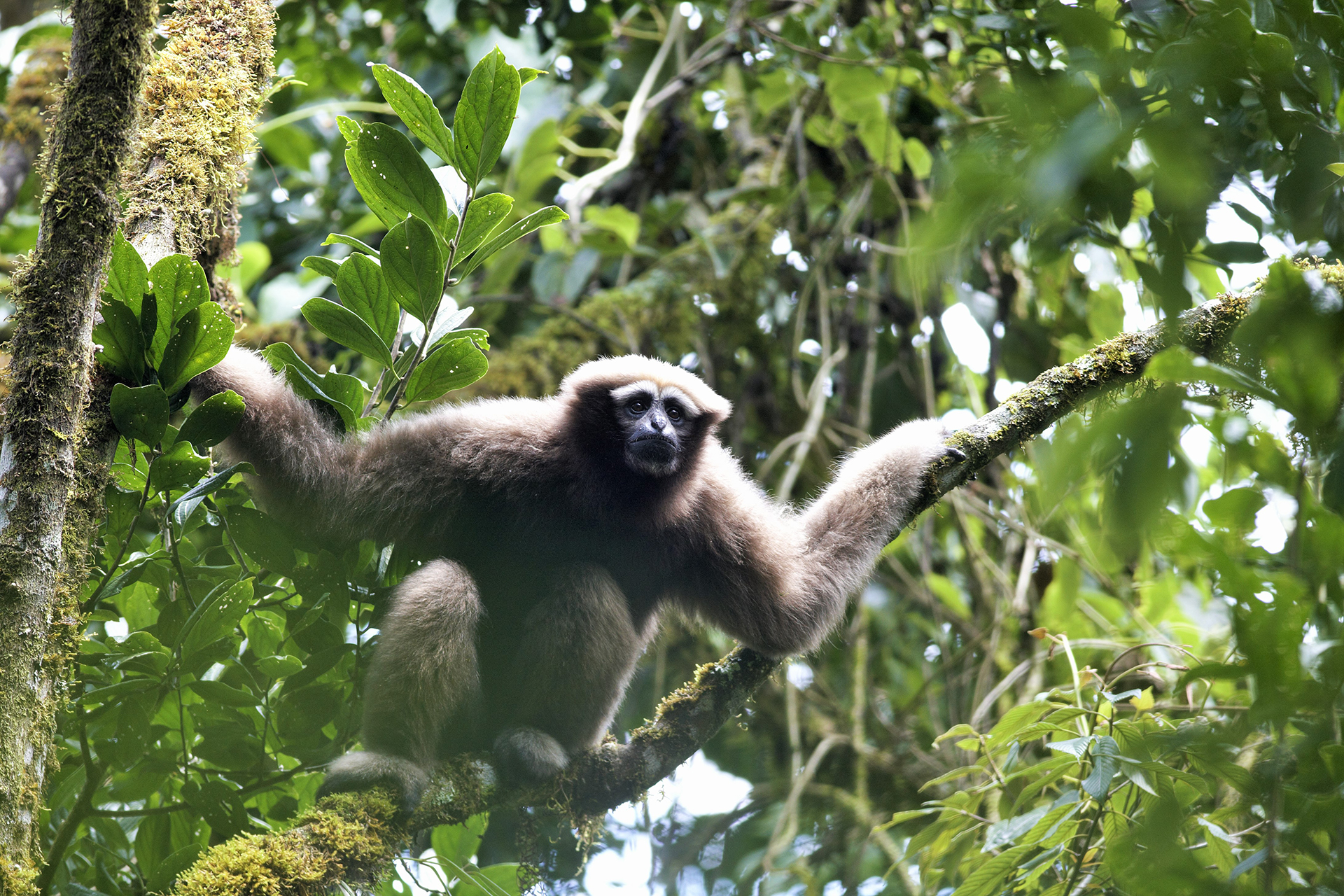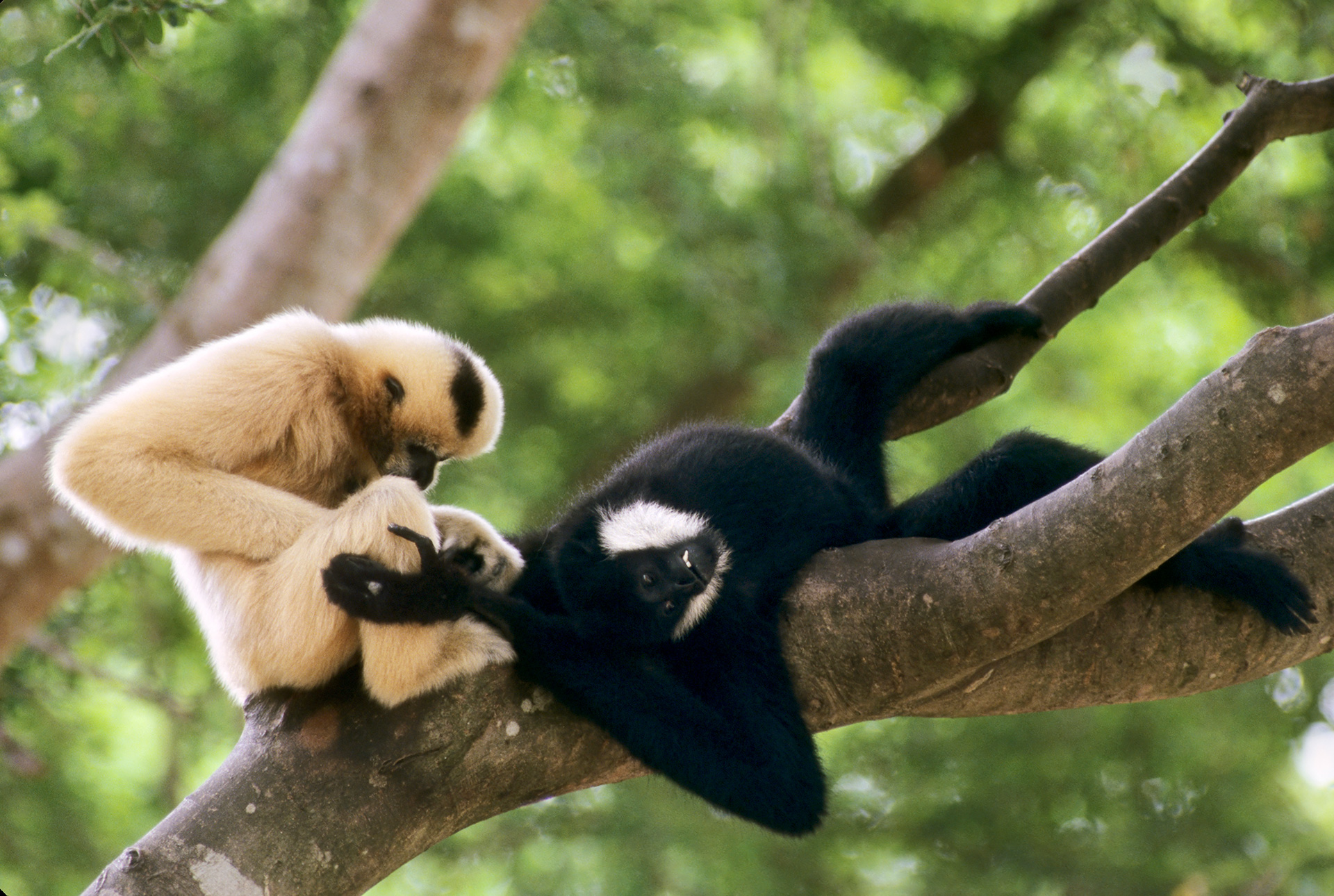We asked a few of our experts why they love gibbons, what their greatest hopes and fears are – and what you can do to help.
Edited for length and clarity.
How did you fall in love with gibbons?
Jayashree
I have moved across my country studying different species, but my mornings were best when I woke up with the calls of the gibbons. Their shy nature and calm attitude attracted my attention. I enjoyed watching them: movements which displayed their great gymnastic skills, jumping about from one tree to another, they played hide and seek with me. Sometimes, I feel they wait till I am close, and then make their move, to give me the perfect shot of the day. I fell in love with them just like that.
My mornings were best when I woke up with the calls of the gibbons… they played hide and seek with me.
Meredith
White-handed gibbons at Khao Yai, Thailand were the first wild apes I ever worked with. I remember well the excitement. I fell in love with the grace of gibbon locomotion, the beauty of their duets, and the female great call.
Judith
When I first heard a gibbon sing, I was in love with them. Their song and the way they move through the canopy, so easy and fast, is what I really love about them.
Inge
I had the opportunity to daily observe a family of gibbons during a habitat assessment. Every morning this group would initiate the morning call after which multiple groups would respond, a beautiful and magical way to start the day.
In the same year a siamang arrived at Cikananga Wildlife Center, which was confiscated from a private zoo and had a severe skin condition. I spent hours with him to give topical treatment. Seeing him transform from a broken soul to an energetic and loud individual is heart-warming.

What’s your proudest moment working with gibbons?
Meredith
Coming in one morning at the zoo to find a healthy baby white-handed gibbon born to a first-time mother.
Susan
The moment Cokolat (one of the wild gibbons at my site in Indonesia) allowed me to follow her for the day. She finally decided I was not a threat and she carried on her normal behaviour and let me observe her. It was her patience and courage with us which led the rest of her family to lose their fear and to allow me into their world.
It was her patience and courage with us which led the rest of her family to lose their fear and to allow me into their world.
Judith
When I gain their trust. Once there was a gibbon knocked out the family group by her parents. She was all alone and did not know what to do. When she saw me, she came to me. I was able to give her some food and I could encourage her into a transport-box (so we could take her to a safe place).
Jayashree
My proudest moment while working with the gibbons was being able to see how new adults, via vocal calling, choose partners to form a new group. It was thrilling to see the practice of getting together to make a new family of their own.
Local people now independently and voluntarily help the gibbons.
Inge
Showing local people that gibbons are worth saving, and seeing that they now independently and voluntarily help the gibbons – by, for example, planting trees.
What’s your greatest hope for gibbons?
Susan
That we can strengthen our movement for gibbon conservation with all the members of the SSA and our supporters. And that this group can really make a difference across the countries where gibbons are found.
Judith
I hope that the gibbons will sing their song in their natural environment for generations to come.
Jayashree
Gibbons are much loved by the people in Assam and I really hope that people know more about this beautiful creature from childhood, which will help for better conservation of the species and its habitat.
Inge
The hope at our project site is that the remaining gibbon families can be protected, and single gibbons in small forest patches can be successfully translocated. Next to that, I hope to provide gibbons that have been in captivity for their whole life an appropriate sanctuary.
I hope that the gibbons will sing their song in their natural environment for generations to come.
And your greatest fear?
Judith
My greatest fear is that the gibbon will be gone forever, and we will never hear their song in their natural environment again.
Jayashree
The gibbon forest of Assam is home to a massive collection of folk medicinal plants. This makes the forest prone to wood poaching, thereby destroying the wildlife. This affects the movement of groups, creating a lot of tension between groups to maintain their territory. Sometimes such tension results in severe fights which can even be fatal, and this increases my fear for them and their existence.
Inge
That the help for some is too late; in some cases, it has been proven that some individuals or families could not be saved. Losing wild gibbons due to habitat loss was hard. Due to ongoing logging and poaching we fear to lose more gibbons at the project site.

How would you invest in gibbon conservation?
Judith
Gibbon education lies at the basis of gibbon conservation. I would invest in raising awareness of this animal and the threats they face.
Jayashree
I would love to run gibbon research by involving young researchers and training them in primatology. I would take up certain conservation methods like educating the locals as well as planting trees, which would help in global biodiversity conservation.
Inge
Besides improving the sanctuary of numerous gibbons that have become victim of pet trade, I would also make protection of the forests remaining on Java possible.
Gibbon education lies at the basis of gibbon conservation.
How is the SSA important for your work?
Inge
Having a platform to ask colleagues for help and advice is an important life line in situations that can arise in a rescue centre, and in human-wildlife conflict situations in the field.
Meredith
The SSA is a great way of linking gibbon experts from a variety of backgrounds to help advise each other and determine the best ways to educate others interested in gibbons outside of the SSA.
Judith
The SSA helps to conserve gibbons. I work in a zoo so to exchange experiences and knowledge is very important for the welfare of the gibbons in captivity. And educating people about gibbons during my work is important as well, especially on International Gibbon Day.
Jayashree
The SSA is very important for my work, as it helps me to keep updated with recent research, and researchers across the globe. It also brings me closer to the gibbon lovers spread globally.
You’ll see quotes from these experts dotted around the site. We’d like to thank them for taking the time to chat with us!
Meredith L. Bastian, PhD. – Curator of Primates at Smithsonian’s National Zoo and Conservation Biology Institute in Washington DC, USA
Dr. Susan M Cheyne – Researcher in Oxford, UK; Vice-Chair of the SSA
Judith van der Loo, MSc. – Animal Keeper and Primatologist at Beekse Bergen Safari Park, Netherlands; member of the SSA Captive Working Group
Jayashree Mazumder – PhD. Scholar at the Indian Institute of Science Education and Research, Mohali, India; SSA Student Representative
Inge Tielen – Conservation Manager at Wanicare Foundation and Cikananga Wildlife Center in Java, Indonesia
